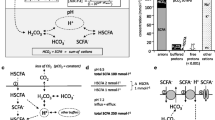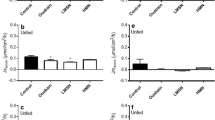Summary
Active H+ transport in the turtle urinary bladder is mediated by an ATPase. Although the source of ATP is usually mitochondrial oxidative phosphorylation, it is possible because of intracellular compartmentalization or cellular heterogeneity that one metabolic pathway exclusively provides ATP to the pump. To examine this we performed several types of experiments. In one, the coupling between the rate of transport and the rate of oxidation of14C-labeled substrates was studied. We found that there was coupling between H+ transport and glucose, butyrate, oleate, and β-OH-butyrate oxidation. In another set of experiments we depleted turtle bladders of their endogenous substrates and tested the effect of a number of substrates on the rate of transport. We found that glucose, pyruvate, lactate, actetate, butyrate and β-OH butyrate all stimulated H+ transport. In a third set of experiments we found no coupling between H+ transport and lactate production. Finally, we found that reduction of H+ transport by mucosal acidification resulted in an increase in epithelial cell ATP concentrations and a decrease in ADP levels.
These results suggest that the H+ pump receives its ATP from carbohydrate and fatty acid oxidation. The changes in ATP and ADP levels provide an initial explanation for the coupling of H+ transport to the rate of cellular oxidative metabolism.
Similar content being viewed by others
References
Al-Awqati, Q. 1977. Effect of aldosterone on the coupling between H+ transport and glucose oxidation.J. Clin. Invest. 60:1240
Al-Awqati, Q., Mueller, A., Steinmetz, P.R. 1977. Transport of H+ against electrochemical gradients in turtle urinary bladder.Am. J. Physiol. 233:F502
Al-Awqati, Q., Norby, L.H., Mueller, A., Steinmetz, P.R. 1976. Characteristics of stimulation of H+ transport by aldosterone in turtle urinary bladder.J. Clin. Invest. 58:351
Beauwens, R., Al-Awqati, Q. 1976. Active H+ transport in the turtle urinary bladder. Coupling of transport to glucose oxidation.J. Gen. Physiol. 68:421
Chen, R.F. 1967. Removal of fatty acids from serum albumin by charcoal treatment.J. Biol. Chem. 242:173
Coplon, N.S., Steele, R.E., Maffly, R.H. 1977. Interrelationships of sodium transport and carbon dioxide production by the toad bladder: Response to changes in mucosal sodium concentration, to vasopressin and to availability of metabolic substrate.J. Membrane Biol. 34:289
Dixon, T.E., Al-Awqati, Q. 1979. Urinary acidification in the turtle bladder is due to a reversible proton-translocating ATPase.Proc. Nat. Acad. Sci. USA 76:3135
Dixon, T.E., Al-Awqati, Q. 1979. H+ pump of the turtle bladder regulates the rate of cellular metabolism by changing the free energy of ATP hydrolysis (ΔG ATP).Kidney Int. 16:41A (Abstr.)
Gutmann, I., Wahlfeld, A.W. 1974. L(+)-Lactate determination with lactate dehydrogenase and NAD.In: Methods of Enzymatic Analysis. H.U. Bergmeyer, editor. Vol. 3, pp. 1464–1468. Academic Press, New York
Hartree, E.F. 1972. Determination of protein: A modification of the Lowry method that gives a linear photometric response.Anal. Biochem. 48:422
Kimmich, G.A., Randles, J., Brand, J.S. 1974. Assay of picomole amounts of ATP, ADP and AMP using the luciferase enzyme system.Anal. Biochem. 69:187
Le Fevre, M.E., Dox, L.J., Brodsky, W.A. 1972. Metabolism of depleted turtle bladder.J. Membrane Biol. 8:205
MacKnight, A.D.C., Civan, M.M., Leaf, A. 1975. The sodium transport pool in toad urinary bladder epithelial cells.J. Membrane Biol. 20:365
Norby, L.H., Schwartz, J.H. 1978. Relationship between the rate of H+ transport and pathways of glucose metabolism by turtle urinary bladder.J. Clin. Invest. 62:532
Rosen, S. 1970. The turtle bladder. I. Morphological studies under varying conditions of fixation.Exp. Mol. Pathol. 12:286
Schwartz, J.H., Steinmetz, P.R. 1977. Metabolic energy and pCO2 as determinants of H+ secretion by turtle urinary bladder.Am. J. Physiol. 233:F145
Steinmetz, P.R. 1969. Acid base relations in epitheliam of turtle bladder: Site of active step in acidification and role of metabolic CO2.J. Clin. Invest. 48:1258
Steinmetz, P.R. 1979. The functional organization of proton and HCO3 transport in turtle urinary bladder.Ann. N.Y. Acad. Sci. (in press)
Thayer, W.A., Tu, Y.L., Hinkle, P.C. 1977. Thermodynamics of oxidative phosphorylation in bovine heart submitochondrial particles.J. Biol. Chem. 252:8455
Ugurbil, K., Brown, T.R., Hollander, J.A. den, Glynn, P., Shulman, R.G. 1978. High-resolution-13C-nuclear magnetic resonance studies of glucose metabolism inEscherichia coli.Proc. Nat. Acad. Sci. USA 75:3742
Whittam, R. 1961. Active cation transport as a pacemaker of respiration.Nature (London) 191:603
Author information
Authors and Affiliations
Rights and permissions
About this article
Cite this article
Kelly, S., Dixon, T.E. & Al-Awqati, Q. Metabolic pathways coupled to H+ transport in turtle urinary bladder. J. Membrain Biol. 54, 237–243 (1980). https://doi.org/10.1007/BF01870240
Received:
Issue Date:
DOI: https://doi.org/10.1007/BF01870240




